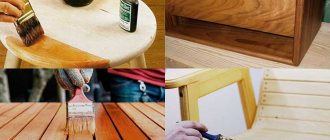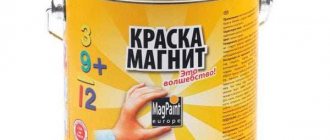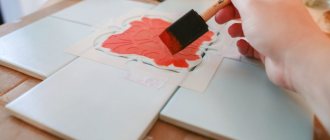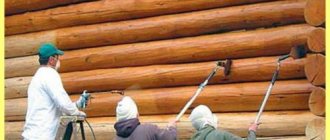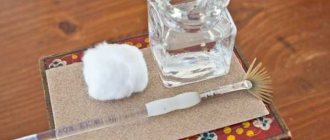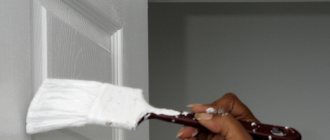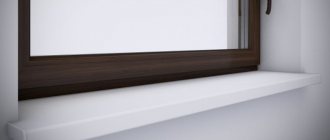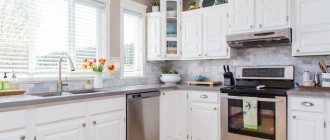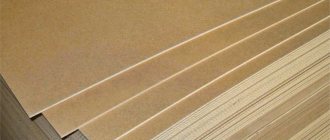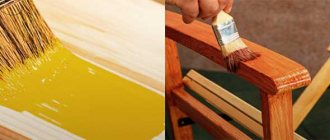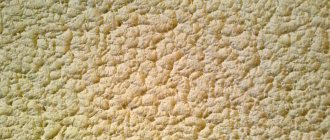Preliminary processing
The preparatory process before coating a wooden surface with varnish consists of:
- Thorough cleaning of surfaces, removing dust, dirt and old paint. This stage is required, otherwise the coating made with varnish or stain will be uneven and will soon begin to collapse.
- Applying a protective agent. Which product is best suited in each specific case is influenced by the conditions in which the object being painted will be used.
- Primer treatment. This is required to improve the adhesion of the varnish to the wooden surface. For interior work, it is permissible to use only water-based products with a non-toxic composition.
How to properly varnish wood
Varnish coatings, which are well known to us, are used in construction for decorative finishing of the surfaces of walls and other elements of wooden buildings. These coatings reliably protect surfaces from destructive climatic influences, which significantly increases their service life. In addition, they provide them with additional attractiveness. The listed advantages of varnish coatings serve as good reasons for becoming familiar with how to properly varnish wood at home.
Surface grinding
wood sanding
Work must be carried out in a room that provides optimal conditions for drying the surface. The temperature in the room should be constant, without sudden changes, approximately 20 °C. There should be no dust or dirt inside, since even the smallest particles of debris can spoil the coating and make it uneven.
Before you start work, you need to prepare all the necessary materials and tools:
- a set of sandpaper (fine-, medium- and coarse-grained);
- wooden rectangular block;
- rubber layer;
- stick of small diameter.
All surfaces that are planned to be treated with water-based varnish or stain must be thoroughly sanded, the resulting wood dust must be collected with a vacuum cleaner, and the surfaces must be treated with a cloth soaked in a solvent. The parts of wood to be painted are pre-treated with abrasive. First, use coarse-grained paper, then sand the surfaces with fine-grained paper.
grater for grinding
To simplify the work, use a block - it is wrapped in sanding paper and smooth surfaces are processed. In this case, the wood processing technology should be taken into account: movements should be directed along the fibers so as not to injure the surface.
For large areas, wrap rubber in sandpaper, and for holes, wrap a stick.
Coating the surface of the product with varnish
To properly coat wood with oil or any other varnish, you need to know how to use various tools. If you decide to use a tampon to apply the composition, you should not dip it into the applied composition, but completely immerse it for high-quality impregnation. After this, you should test the soaked swab on an unwanted piece of wood. This test allows you to determine the optimal pressing force on the swab when varnishing. As soon as it is possible to achieve acceptable quality of the coating without smudges, you can begin processing the main wooden product.
When applying varnish with a brush, the layer should be as thin as possible
Tamponing allows you to create very attractive varnished surfaces by applying the varnish with quick movements along the grain of the wood. Be sure to ensure that the edges of the applied strokes do not overlap each other, otherwise the color of the product after applying paints and varnishes will not be uniform. If, as the composition on the tampon is used up, the layer of varnish becomes thinner and thinner, you will need to increase the pressure on the tampon. To create a well-protected surface, 2 or 3 layers of varnish should be applied to it, and each layer must be completely dry before applying the next one.
The second method of varnishing involves working with a brush. The layer of varnish mixture applied with a brush should be as thin as possible, so the brush should be wrung out periodically while working. Brush movements when applying the composition should be smooth, otherwise air bubbles may appear on the surface. As in the case of a tampon, you need to brush the wood 2 or 3 times, waiting for the layers to dry completely.
Applying the varnish mixture with a sprayer allows you to smoothly, efficiently and accurately process almost any surface with minimal time. You can only work with a spray gun using personal protective equipment and in well-ventilated areas, since the smallest particles of varnish can accumulate in the air. When applying varnish, you must constantly keep the sprayer at the same distance from the workpiece and move it at the same speed.
The last stage of varnishing is surface polishing. Polishing should be done after the last layer of the applied composition has completely dried. For polishing you need to use a special paste, polish, and special swabs. First, you need to lightly sand the surface with fine-grained sandpaper to remove minor irregularities, then wipe the product with a soft cloth and only then begin polishing.
Apply a thin layer of paste to the wood using a swab in a quick, zigzag motion. When the product becomes smooth enough, the paste or polish needs to be dried. Apply the next layer of paste to the surface 12 hours after the first. To ensure the product has a mirror shine, you will have to apply at least 3 layers of paste.
Wood protection products
To prevent the wood from deteriorating, it should be treated with impregnation before coating it with varnish or stain.
You need to choose a product taking into account several factors: operating conditions (indoors or outdoors), temperature conditions and climatic features.
Antiseptics
Water-based antibacterial impregnations prevent the appearance of mold or fungi on wooden surfaces. Antiseptics have a very toxic composition, so it is not recommended to use them on products that are planned to be used in a residential area.
Wood protection products
Fire retardants
Such compositions significantly reduce the natural flammability of wood products, and if a fire occurs, they prevent its rapid spread. They are used for surfaces that are located close to fire sources.
Insecticidal compounds
They serve as reliable protection against insects. They are used to treat outdoor wooden surfaces, garden furniture and other items that will be outdoors.
Water-repellent impregnations
They are used to protect wood from swelling when wet, cracking and deformation when drying. Products of this type penetrate deep into the wood, filling the pores of the material, and after final drying they provide a reliable water-repellent layer.
Such impregnations can be used for surfaces of products used in damp rooms and outdoors.
Combined products
Liquids that perform two or more functions, such as preventing insects and mold. They are used in cases where surfaces need to be protected from several potential threats. Consecutive use of several products takes more time and effort, and is more expensive, and combined products in this case are the best choice.
Preparing tools and work area
For high-quality varnishing of wooden surfaces, you will need working tools.
If you use traditional varnish in jars, then you cannot do without brushes. Their size and quantity are chosen depending on the volume of work and the types of varnish used. Preference should be given to brushes made of natural bristles.
To process small wooden products, as well as various planks and rods, you can use narrow brushes with a width of 15 to 20 mm.
When processing large surfaces, it is advisable to use flute brushes with a width of 100-150 mm.
Rollers are also used to process large areas, but unlike flute brushes, they are inconvenient for varnishing curved surfaces.
At home, you can varnish the surface with a spray can, but it is more expensive and is used only for small products.
Sandpaper is needed for mechanical cleaning of wooden surfaces and sanding them before varnishing. For processing, you need to have several types of sandpaper of different grain sizes. You will need a brush that can be used to sweep away dust from the prepared surface.
A grinding machine is used if it is necessary to prepare very large surfaces for varnishing. A vacuum cleaner is used to remove dust during grinding, as well as to clean large-sized products.
Having collected all the necessary tools, you need to prepare the room if the work will be carried out inside. It is necessary to take into account the possibility of ventilation, since many varnish compositions emit substances harmful to the human body and have a pungent odor.
The room should be bright enough so that the result of the work can be visually monitored. If necessary, you need to provide the workplace with artificial lighting. If you plan to use power tools, such as sanders or a vacuum cleaner, make sure your work area has electrical outlets and suitable extension cords.
Surface priming
There are soil fluids on different bases.
wood priming
When choosing a primer, it is important to take into account not only the degree of toxicity of the liquid (it is unacceptable to use products that emit harmful compounds in residential premises), but also its structure. The primer must have a composition compatible with stain or water-based varnish. Otherwise, there is no guarantee that the coating will not begin to peel or bubble.
Alkyd
It is recommended for use in rooms with high humidity or for outdoor work. Most often it is used to prepare the floor or walls in a bathhouse or sauna before painting. Properties of this type of primer: filling the pores of wood, protecting against swelling of fibers.
Acrylic primer
Its main advantages: the ability to penetrate deeply into the structure of the material, the absence of toxic substances, and rapid drying.
Water-based acrylic primers can be supplemented with various components to improve their protective properties. For example, liquids for pre-treatment of wood can be added to them, in which case there is no need to coat the surfaces with impregnation.
Types of frost-resistant varnishes
Today, many frost-resistant varnishes are produced for outdoor use. To make the right choice and not make a mistake, you need to know what types of compounds there are and what characteristics they have. Most varnish products do not affect the natural pattern of wood, its texture; varnishes practically do not change the color of the wood.
Modern varnishing solutions can be produced on an organic, water or oil basis. Each of them, after drying, creates a durable but elastic film that protects the surface from moisture penetration and creates a protective layer against mechanical damage, even when exposed to extremely low temperatures.
Many frost-resistant varnishes for exterior woodwork contain special additives that provide protection not only from moisture, but also from the growth of fungi and mold, as well as from the negative effects of ultraviolet rays, changes in shade and cracking. The type of frost-resistant varnish you choose must have the following important characteristics:
- good vapor permeability;
- water repellency;
- resistance to mechanical stress, deformation and damage;
- resistance to ultraviolet radiation;
- high impact resistance.
Frost-resistant varnishes may contain various components; depending on this, these varnish mixtures can be divided into the following categories:
- paint and varnish products based on organic solvents;
- water scuba gear;
- alkyd-urethane solutions;
- oil compositions;
- yacht mixtures. They are the most durable, wear-resistant and frost-resistant.
According to their purpose, varnishes can be divided into the following types:
- universal mixtures that can be used not only for wood, but also for stone, concrete, and other materials;
- varnish solutions for furniture and wood structures.
- Based on the type of gloss, matte, semi-matte and glossy mixtures are distinguished.
Paint and varnish products made on the basis of organic solvent are very popular. Such mixtures harden when the solvent completely evaporates, after which a highly durable protective layer is formed. Almost every frost-resistant wood varnish with a solvent is suitable for application outdoors; it is highly resistant to abrasion and washing with chemical detergents. Among the disadvantages of organic solvents, one can highlight the change in the color of wood; the solvent burns the wood and adds a yellow tint to it.
Some people choose frost-resistant varnish with a water-soluble base, but it has little abrasion resistance. Despite this, water-based varnishes are environmentally friendly and safe for humans, and they dry fairly quickly.
The most durable type of varnish is alkyd-polyurethane. Such solutions have excellent performance properties. Oil-based varnish mixtures also have good characteristics, but they can change the shade of a wooden product, making the color darker.
Often in our time, yacht varnishes are used for wood, stone, and other building materials. Yacht varnish mixtures have all the necessary properties regarding strength, durability and elasticity required for paint and varnish products. Yacht compositions have increased frost resistance, and have excellent water-repellent properties, repel dirt and other contaminants. This variety is applied very easily and quickly, without leaving streaks.
Using wood stain
The wood surface should be painted with stain in the same way as with regular paint. The only thing is that this impregnation dries very quickly, so you should work just as quickly, but carefully.
Before completing the work, you must not allow the stain layer to dry, otherwise a seam in this place will be clearly visible, different from the rest of the surface. That is why you should not put a lot of solution on the brush.
To paint a wooden surface with stain, use:
- Paint brush.
- Foam roller.
- Automatic or manual sprayer.
The stain is applied parallel to the direction of the wood grain and therefore should not be applied to another section unless the first is finished. In the place where the two sections are connected, it is necessary to ensure that the applied layers of impregnation do not overlap each other.
Thanks to stain, wood acquires a refined and excellent color. In addition, it protects and enhances the wood grain. After the planed plank floor is laid, it is necessary that it is always clean, otherwise, after applying the stain, all the stains will begin to stand out.
If there are greasy stains on the floor, the stain in this area may not be absorbed into the wood. If the wooden parquet is in good condition and there is no need to restore or putty it, then covering it with such impregnation is an excellent solution to renew the old parquet.
If you need to get a new shade, you can mix several stain colors
You need to stir carefully so that splashes do not fall on the floor, as such stains will subsequently stand out very strongly. It is recommended to mix only compatible components
How to properly care for a polished surface?
Do-it-yourself wood waxing composition
Finishing wood using polish makes it mirror-smooth. Dust and other contaminants are less likely to be retained on such a surface. It becomes more resistant to moisture present in the air. However, this type of finishing is not able to completely protect the product from external influences. For example, when touching a sharp or rough object, scratches appear on polished wood. Under the influence of high temperature, the polish may lose its original strength and “float”.
All these points should be taken into account when choosing a finishing method and subsequent operation of this product. You should not polish objects that will be subject to active use, for example, the horizontal surface of a tabletop. Any hard object left on it, such as keys, can damage it and leave scratches. High temperatures damage polished wood, so items made from it should not be left in the sun or near heating devices for a long time. Contact with water and water vapor should be avoided.
In order for the item to remain beautiful and serve for a long time, it is protected from getting wet, overheating, and contact with sharp objects. For care, it is recommended to use special compounds for polished furniture, which are sold in household chemicals departments. A small amount of this composition is applied to a napkin and the wood is wiped with it. Heavy stains can be removed with warm water and a small amount of dishwashing gel. The washed surface is immediately wiped with a dry cloth and treated with polish.
Methods of varnishing wooden surfaces
Flawless application of varnish on wood is done using special tools. They are selected based on the volume of work to be done and personal preferences.
Roller
Designed for covering smooth surfaces with the material. Using a roller you can quickly cover large areas. Moreover, the varnish will be applied in an even layer. Additionally, you will need to purchase a plastic tray.
The use of a roller is advisable for large areas with a flat surface Source baltija.eu
